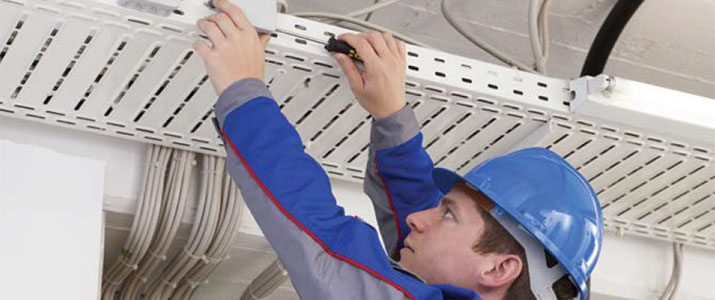
Retrofit to IP
Using legacy cable to save costs and manpower
 Choice, cost savings, speed of deployment and convenience. This
is what the use of existing legacy cable can afford the end-user as
they migrate existing, analog-based surveillance, access control
or intercom systems to IP.
Choice, cost savings, speed of deployment and convenience. This
is what the use of existing legacy cable can afford the end-user as
they migrate existing, analog-based surveillance, access control
or intercom systems to IP.
Using existing cable should be considered because there is no
need to purchase or pull new cable. The facility can remain operational as there is
no cable to install, remove or recycle. There also is cost savings by using existing
cable that can be used toward more and better cameras as well as vertical applications
like elevators, tunnels, mines, subways and train stations with closed-cable
bundles which typically need to use the cable they already have. Plus, it is less
expensive than fiber.
Lack of Choice
For decades, tens of millions of analog-based, CCTV cameras have been connected
to recording and control equipment via coaxial cable. In fact, about 80 percent
of analog cameras installed via coax have cable runs greater than the defacto
Ethernet standard of 328 feet, actually more like 500-600 feet on average.
There are a lot of customers in the security market today being told that the
only way to deploy an IP video surveillance network is to remove the coax cable,
and “flood wire” the project with Cat-5 or Cat-6 structured cabling.
But, what about those long, formerly analog device runs? Yet again, the industry
is telling people to simply repeat the signal somewhere before the 328 foot interval.
And, at that IDF mid-span point—if you can find one—supply the cable extender/
repeater with yet-to-be-installed mains power. That can be expensive. Also,
per National Electric Code (NEC), all the old cable has to be removed, which is
not very green and yet, another expense. The dirty secret here is that installers
aren’t always removing the old cable; they should, but they don’t.
A Viable Alternative
An alternative choice to the time consuming and costly scenario described above
is to use the existing cable and a hybrid IP transmission system. There are IP migration
transmission systems, called “IP over any cable,” on the market today that
allow installers and end users to take advantage of the extended PoE power and
Ethernet distance benefits using legacy wire.
More or less, this hybrid technology allows you to use whatever cable is available
and in decent shape for the IP migration, whether it is coax, UTP, 2-wire or
some other copper wire, twisted or untwisted. This robust IP migration technology allows installers to approach their customers with a whole new tool kit of
migration choices and varied benefits.
IP-over-any-cable technology features
and benefits include:
- Allows the use of any type of cable
over almost any distance and via any
topology;
- overcomes the Ethernet data extender/
repeater 328-foot distance
limitation;
- 50 Watts of PoE power for IP devices—
cameras, intercom, access
control—at extended distances;
• use of one cable to supply IP and
PoE connectivity to multiple IP
cameras/devices; and
- usable system diagnostics and monitoring.
The flexibility of these IP migration
solutions provides cost-effective, simple
and seamless migration avoiding forklift
flood-wire installations.
If one were to install an entirely
new Ethernet network infrastructure,
the project would typically be done in
one complete, disruptive and expensive
pass. The size of the project typically
forces a large, expensive, operationallydisruptive,
network retrofit on the end
user. In the case of a hospital, for example,
they rarely have the luxury of
displacing patients or shutting down
large areas of their facility. Shut downs
mean loss of revenue and reductions in
quality of care. So, when they are looking
to retrofit, this hybrid solution can
make sense.
Variety of Cables
and Topologies
Native to most building cabling infrastructures
is the fact that there have
been hosts of cabling types and sizes
installed over time. One may think that
this is just a mess; others may think it
is a resource to be used. IP-over-anycable
technology allows multipoint
network operation using any star- or
daisy-chained cabling topologies and
with any combination therein. So, connect
UTP to coax to UTP and back to
coax, in any topology.
Conventional Ethernet has a pointto-
point distance limitation via UTP
of 328 feet. For the installer, if the
transmission distance is longer, that
typically means IDF closets are in odd
locations throughout the facility in
order to create a proper repeater data
and power supply point. This usually
involves the installation of a lockable
closet or NEMA box.
A typical analog camera has a transmission
distance in excess of 500 feet.
So, with a 328-foot Ethernet distance
limitation that 500 feet would require at
least one newly-installed IDF with accompanying
Ethernet extenders. And,
don’t forget to place or supply power
at the IDF and NEMA box. The added
expense includes the box, the power being
supplied, the extender and labor.
With this hybrid IP-over-any-cable
solution, as much as 56VDC PoE power
is provided from the control room,
with up to 50 watts distributed to the
IP camera and device end transmission
product. No repeaters are ever
required, and cameras and other IP devices
can operate from the same UPS as
other control room equipment.
The typical coax-based IP migration
product on the market is either pointto-
point, meaning there is one locallypowered
transceiver at the camera and
one locally-powered transceiver at the
control room, or it is powered from a
PoE port on a PoE switch. This is not
efficient for multi-camera systems.
With a hybrid IP receiver hub at the
control room, the system’s potential is
maximized by supporting multiple remote
transceivers and their cameras.
This technology is able to leverage one
cable to supply transmission connectivity
to multiple cameras. Yes, more than
one IP device can be connected to one
cable. This results in an easy and costeffective
IP device (camera) upgrade
with minimal installation labor, while
fully leveraging the customer’s investment
in legacy cable.
Incremental Migration
Is Possible
Extended distance and the wiring topology
flexibility are nice too, but the
best part about this technology is that
it affords the customer a choice of
what camera or device is changed out
and when. Not everyone can afford a
network-wide upgrade to IP. The most
important thing is to have the right capability
in the correct location.
With this hybrid IP technology,
single cameras can be removed and
swapped out for several in that location,
allowing for greater image coverage
and quality. All this choice allows
the end-user’s operations to control
the project’s impact on the work
schedule.
These cable-flexible, IP, media converter
solutions are not limited to the
support of IP cameras. Due to its flexibility
via any cable or topology, it can
easily be used to provide Ethernet/PoE
throughout the facility for access control,
wireless access point support, IP phones,
door stations, guard shacks or any other
Ethernet transmission application.
The elegance of this flexible, hybrid
solution is its simplicity of design and
application. Installation is easy; data is
robust and reliable; and everyone saves
money. This technology enables more
installers to approach an IP migration
project with a new set of financial
and installation deployment
options.
This article originally appeared in the August 2014 issue of Security Today.